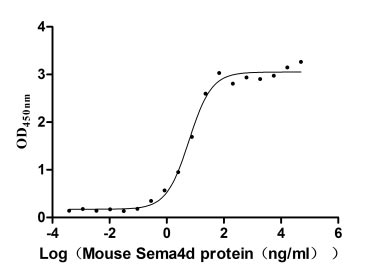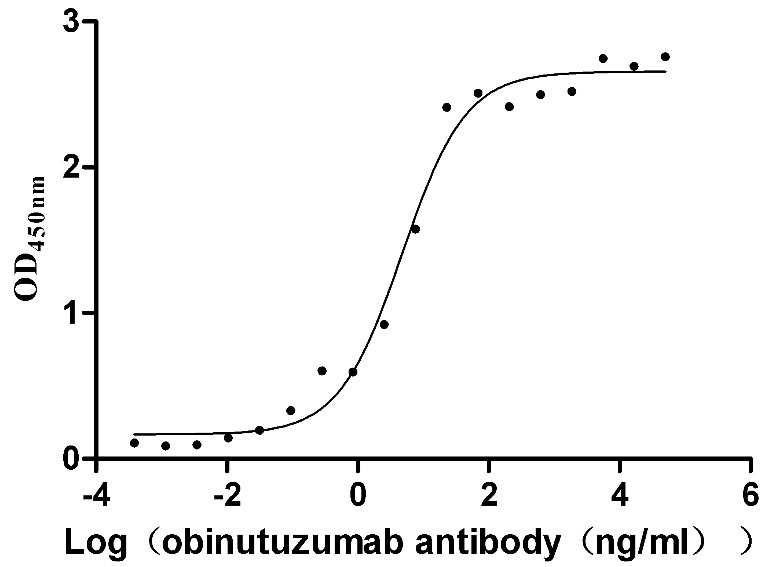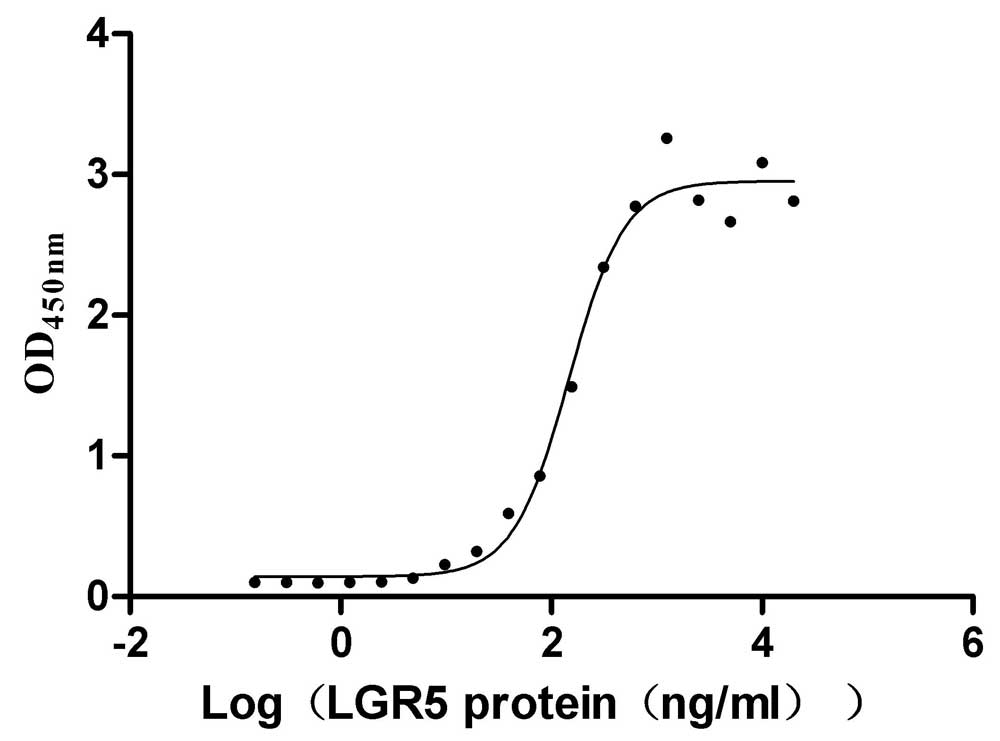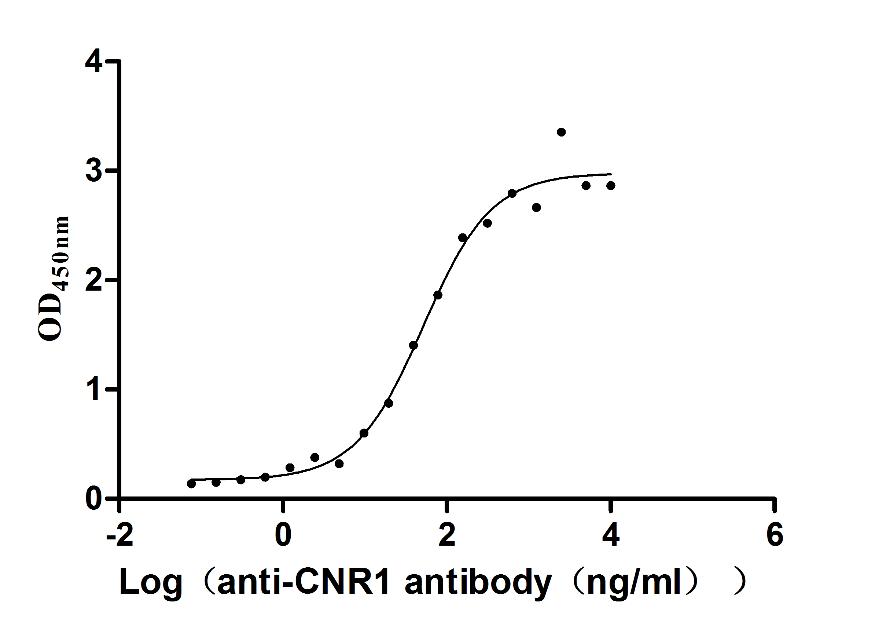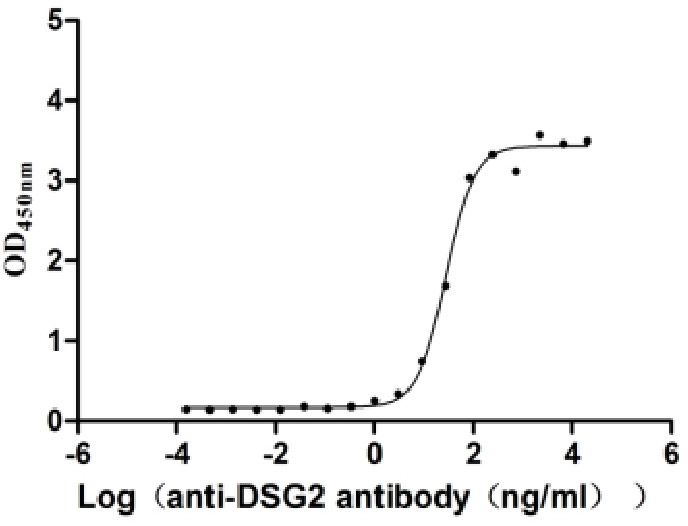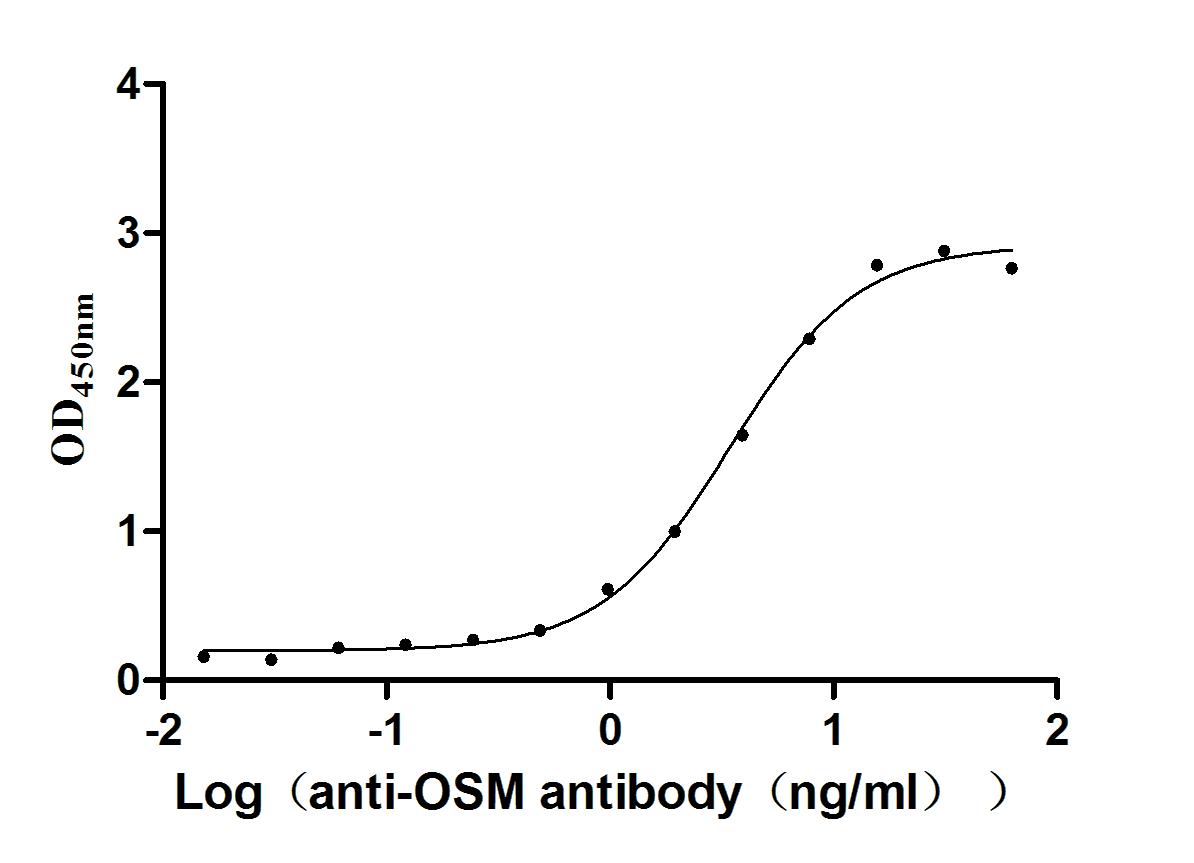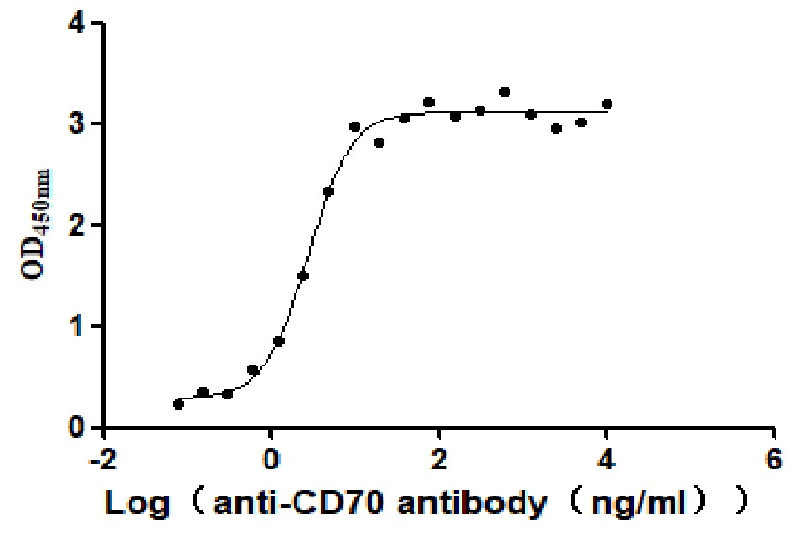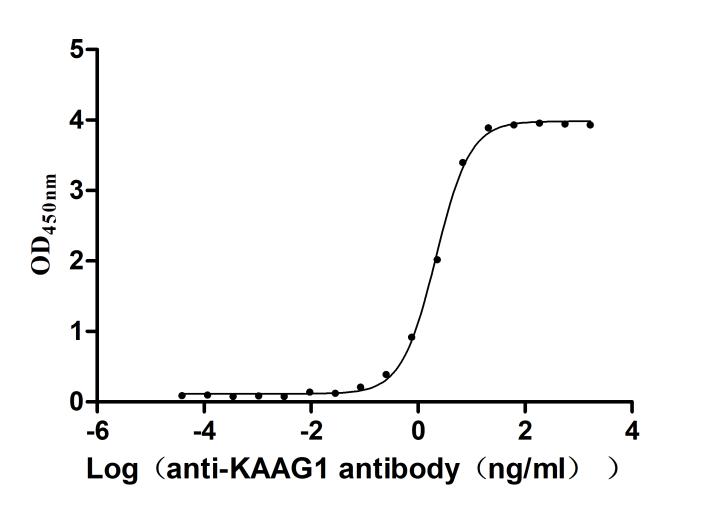Recombinant Human P protein (OCA2 D15S12 P)
-
中文名稱(chēng):
-
貨號(hào):CSB-YP219354HU
-
規(guī)格:
-
來(lái)源:Yeast
-
其他:
-
中文名稱(chēng):
-
貨號(hào):CSB-EP219354HU
-
規(guī)格:
-
來(lái)源:E.coli
-
其他:
-
中文名稱(chēng):
-
貨號(hào):CSB-EP219354HU-B
-
規(guī)格:
-
來(lái)源:E.coli
-
共軛:Avi-tag Biotinylated
E. coli biotin ligase (BirA) is highly specific in covalently attaching biotin to the 15 amino acid AviTag peptide. This recombinant protein was biotinylated in vivo by AviTag-BirA technology, which method is BriA catalyzes amide linkage between the biotin and the specific lysine of the AviTag.
-
其他:
-
中文名稱(chēng):
-
貨號(hào):CSB-BP219354HU
-
規(guī)格:
-
來(lái)源:Baculovirus
-
其他:
-
中文名稱(chēng):
-
貨號(hào):CSB-MP219354HU
-
規(guī)格:
-
來(lái)源:Mammalian cell
-
其他:
產(chǎn)品詳情
-
純度:>85% (SDS-PAGE)
-
基因名:P
-
Uniprot No.:
-
別名:P protein; Melanocyte-specific transporter protein; Pink-eyed dilution protein homolog; OCA2 D15S12 P
-
種屬:Homo sapiens (Human)
-
蛋白標(biāo)簽:Tag?type?will?be?determined?during?the?manufacturing?process.
The tag type will be determined during production process. If you have specified tag type, please tell us and we will develop the specified tag preferentially. -
產(chǎn)品提供形式:Liquid or Lyophilized powder
Note: We will preferentially ship the format that we have in stock, however, if you have any special requirement for the format, please remark your requirement when placing the order, we will prepare according to your demand. -
復(fù)溶:We recommend that this vial be briefly centrifuged prior to opening to bring the contents to the bottom. Please reconstitute protein in deionized sterile water to a concentration of 0.1-1.0 mg/mL.We recommend to add 5-50% of glycerol (final concentration) and aliquot for long-term storage at -20℃/-80℃. Our default final concentration of glycerol is 50%. Customers could use it as reference.
-
儲(chǔ)存條件:Store at -20°C/-80°C upon receipt, aliquoting is necessary for mutiple use. Avoid repeated freeze-thaw cycles.
-
保質(zhì)期:The shelf life is related to many factors, storage state, buffer ingredients, storage temperature and the stability of the protein itself.
Generally, the shelf life of liquid form is 6 months at -20°C/-80°C. The shelf life of lyophilized form is 12 months at -20°C/-80°C. -
貨期:Delivery time may differ from different purchasing way or location, please kindly consult your local distributors for specific delivery time.Note: All of our proteins are default shipped with normal blue ice packs, if you request to ship with dry ice, please communicate with us in advance and extra fees will be charged.
-
注意事項(xiàng):Repeated freezing and thawing is not recommended. Store working aliquots at 4°C for up to one week.
-
Datasheet :Please contact us to get it.
相關(guān)產(chǎn)品
靶點(diǎn)詳情
-
功能:Could be involved in the transport of tyrosine, the precursor to melanin synthesis, within the melanocyte. Regulates the pH of melanosome and the melanosome maturation. One of the components of the mammalian pigmentary system. Seems to regulate the post-translational processing of tyrosinase, which catalyzes the limiting reaction in melanin synthesis. May serve as a key control point at which ethnic skin color variation is determined. Major determinant of brown and/or blue eye color.
-
基因功能參考文獻(xiàn):
- The results of this study is the first to show an association between OCA2 variants and time to first cSCC post-transplant. PMID: 28456133
- Evaluated the association of seven OCA2-HERC2 SNPs and haplotypes with pigmentation characteristics (eye, skin, hair and freckles) in the highly admixed and phenotypically heterogeneous Brazilian population. Such SNPs and haplotypes could be deemed as good predictors for the presence of freckles and for skin, eye and hair pigmentation in the Brazilian population. PMID: 28081795
- We analyzed five SNPs located in the 44.2 kb region and three SNPs outside this region with strong selective signals. Under the additive genetic model, we detected a significant association of rs1800414 with skin pigmentation for both exposed and unexposed areas consistent with a previous association analysis of rs1800414 No significant association was observed for the other seven SNPs (P > 0.05) PMID: 26744415
- Two nonsynonymous OCA2 polymorphisms (rs1800414 and rs74653330) are independently associated with normal skin pigmentation variation in East Asian populations and have very different frequency distributions in East Asia. PMID: 25809079
- The two mutations (c.1114delG in the TYR gene and c.1426A>G in the OCA2 gene) may be responsible for partial clinical manifestations of Oculocutaneous albinism. PMID: 25919014
- variations in OCA2 might have developed by diversifying selection. PMID: 25469862
- individuals from ''El Santuario and Marinilla, Antioquia'', genetically isolated northwestern towns in Colombia well known for its high albinism prevalence [7], were all homozygous for the previously reported p.A787T mutation in OCA2 gene PMID: 25455140
- REVIEW: current hypotheses and the available data on the mechanism of OCA2 transcriptional regulation and how this is influenced by genetic variation PMID: 24387780
- 4 heterozygous mutations of the P gene were found two Chinese families affected with oculocutaneous albinism type . PMID: 25119903
- The most disease-associated mutation of R305W which corresponds to OCA2 results showed prominent loss of stability and rise in mutant flexibility values in 3D space. PMID: 23824587
- Functional characterization of two novel splicing mutations in the OCA2 gene associated with oculocutaneous albinism type II. c.2139G>A represents the first exonic splicing mutation identified in an OCA2 gene. PMID: 24361966
- given a particular HERC2/OCA2 genotype, males are more prone to have lighter eye colors than predicted by their genotypes, while females tend to have darker eye colors than predicted PMID: 23601698
- We examined the association between 12 variants of four pigmentation-related genes (TYR, OCA2, SLC45A2, MC1R) and variations in the melanin index of 456 Japanese females using a multiple regression analysis. PMID: 23165166
- The discovery of this novel OCA2 variant adds to the body of evidence on the detrimental effects of OCA2 gene mutations on pigmentation and supports existing GWAS data on the relevance of the OCA2 gene in melanoma predisposition. PMID: 23103111
- Although variants within OCA2 were tested for association, the 2.7kb deletion allele of OCA2 was not tested. This led us to hypothesize that the deletion allele may confer resistance to susceptibility PMID: 23063908
- Three mutational alleles, R278X and R52I of the TYR gene and C229Y of the SLC45A2 gene, are added to the mutational spectra of Korean patients with oculocutaneous albinism (OCA) PMID: 22042571
- In this paper I shall discuss the anatomy and genetics of normal eye colour, together with a wide and diverse range of conditions that may produce an alteration in normal iris pigmentation or form. PMID: 21979861
- Using quantitative multiplex fluorescent PCR and very high-resolution array-CGH focussed on the OCA2 gene and surrounding regions in 15q12, study identified 2 new gene deletions and 1 duplication in Oculocutaneous albinism type 2 patients. PMID: 21085994
- ). Sequence variations in rs11636232 and rs7170852 in HERC2, rs1800407 in OCA2 and rs16891982 in MATP showed additional association with eye colours PMID: 20457063
- role in pigmentation characteristics in Spanish population PMID: 20629734
- Inheritance of a novel mutated allele of the OCA2 gene associated with high incidence of oculocutaneous albinism in a Polynesian community. PMID: 20019752
- The non-synonymous polymorphism rs1800414 (His615Arg) located within the OCA2 gene is significantly associated with skin pigmentation in this sample. PMID: 20221248
- role of P protein and tyrosinase in oculocutaneous albinism PMID: 12028586
- P gene, in part, determiontes normal phenotypic variation in human eye color and may represent an inherited biomarkers of cutaneous cancer risk PMID: 12163334
- A 122.5-kilobase deletion of the P gene underlies the high prevalence of oculocutaneous albinism type 2 in the Navajo population PMID: 12469324
- We show that OCA2 has measurable effects on skin pigmentation differences between the west African and west European parental populations. PMID: 12579416
- two missense substitutions, A481T and Q799H in the P gene in oculocutaneous albinism PMID: 12727022
- A candidate gene for pigmentation. PMID: 12817591
- 9 novel mutations and 12 novel polymorphisms associated with oculocutaneous albinism type II are reported. PMID: 15712365
- we show that MM and OCA2 are associated (p value=0.030 after correction for multiple testing). PMID: 15889046
- The macular hypoplasia has to be considered a concerted interaction with compound heterozygous mutations in the P gene manifesting a mild form of oculocutaneous albinism. PMID: 16453125
- Differences within the 5' proximal regulatory control region of the OCA2 gene alter expression or messenger RNA-transcript levels and may be responsible for eye-color and other pigmentary trait associations. PMID: 17236130
- These findings suggest that OCA2 481Thr arose in a region of low ultraviolet radiation and thereafter spread to neighboring populations. PMID: 17568986
- results confirm that OCA2 is the major human iris color gene and suggest that using an empirical database-driven system, genotypes from a modest number of SNPs within this gene can be used to accurately predict iris melanin content from DNA PMID: 17619204
- 3 different haplotypes (TAGCT, TAGTT and TAGCC with frequencies of 0.66, 0.28 and 0.06, respectively) associated with the mutation in the 53 OCA2 patients, while 11 different haplotypes were observed in the control group PMID: 17767372
- Pink-eye-dilution gene mutations underlie oculocutaneous albinism in this family. Two known mutations in MC1R caused red hair color in one family member. No modifier effect of MC1R on P mutations could be deduced. PMID: 17960121
- Variation present in the OCA2 gene and perhaps some other pigment related genes must be taken into account in order to explain the high phenotypic variation in iris colour. PMID: 18093281
- Most patients with AROA (autosomal recessive ocular albinism) represent phenotypically mild variants of oculocutaneous albinism , well over half of which is OCA1. PMID: 18326704
- OCA2 and HERC2 have roles in hair color in Australian adolescents PMID: 18528436
- strong correlations in MATP-L374F, OCA2, and melanocortin-1 receptor with skin, eye, and hair color variation, respectively PMID: 18650849
- Oculocutaneous albinism phenotype (OCA2) can be modified by mutation in TYRP1. PMID: 18680187
- TYR is the major OCA (oculocutaneous albinism) gene in Denmark, but several patients do not have mutations in the investigated genes. PMID: 19060277
- OCA2 is targeted to and functions within melanosomes but that residence within melanosomes may be regulated by secondary or alternative targeting to lysosomes. PMID: 19116314
- It is concluded that OCA2 rs1800407 is associated with eye colour. PMID: 19208107
- The variant allele of OCA2 R419Q (rs1800407) is associated with increased risk of malignant melanoma. PMID: 19320733
- Polymorphism of pigmentation genes (OCA2 and ASIP) in some populations of Russia PMID: 19382693
- The OCA2 Arg419Gln is associated with basal cell carcinoma PMID: 19384953
- Three single nucleotide polymorphisms found within intron 1 of the OCA2 gene (rs7495174, rs4778241, rs4778138). 30 UTR region (rs1129038) of the HERC2 gene PMID: 19472299
- In 5 israeli families a P gene mutation was detected. PMID: 19626598
- Human DNA sequences;hair colour PMID: 8875191
顯示更多
收起更多
-
相關(guān)疾病:Albinism, oculocutaneous, 2 (OCA2)
-
亞細(xì)胞定位:Melanosome membrane; Multi-pass membrane protein.
-
蛋白家族:CitM (TC 2.A.11) transporter family
-
數(shù)據(jù)庫(kù)鏈接:
Most popular with customers
-
Recombinant Mouse Semaphorin-4D (Sema4d), partial (Active)
Express system: Mammalian cell
Species: Mus musculus (Mouse)
-
Recombinant Human B-lymphocyte antigen CD20 (MS4A1)-VLPs (Active)
Express system: Mammalian cell
Species: Homo sapiens (Human)
-
Recombinant Human R-spondin-1 (RSPO1), partial (Active)
Express system: Mammalian cell
Species: Homo sapiens (Human)
-
Recombinant Human Cannabinoid receptor 1 (CNR1)-VLPs (Active)
Express system: Mammalian cell
Species: Homo sapiens (Human)
-
Recombinant Human Desmoglein-2 (DSG2), partial (Active)
Express system: Mammalian cell
Species: Homo sapiens (Human)
-
Recombinant Human Oncostatin-M (OSM), partial (Active)
Express system: Mammalian cell
Species: Homo sapiens (Human)
-
Recombinant Human CD70 antigen (CD70), partial (Active)
Express system: Mammalian cell
Species: Homo sapiens (Human)
-
Recombinant Human Kidney-associated antigen 1 (KAAG1) (Active)
Express system: E.coli
Species: Homo sapiens (Human)


